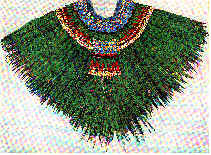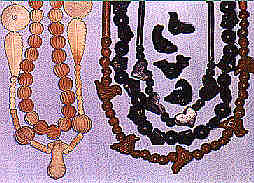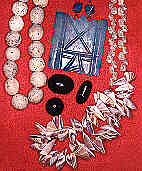The Bead SiteHome> Trade Beads> The Americas > Spanish Impact
The Spanish Impact on Traditional Beadmaking
in America
This item deals with Mexico. It may be applicable to most of Latin America, though perhaps not to such an extent.
Beads were very important to pre-contact cultures in America. Royal tombs, such as Tomb No. 7 of Monte Albán, were full of beads of jade, turquoise, spondylus shell, pearls, amber, gold and silver. The beadmakers were likely considered high craftsmen, and many were probably attached to the court.
The Spanish changed all of that. They destroyed every native industry they could, except those that were useful to them, such as pottery. They melted down the gold and silver, crushed the jade and drank it for medicine, built churches over the temples and burnt the painted manuscripts.
|
Sixteenth century Spaniards had no use for beads except for rosaries, mostly made in Europe and imported to the Americas. They brought European beads for trade, but soon disdained even that. Trade beads that reached Mexico during Spanish occupation came principally from China through the Galleon trade. These include the "Padre beads" of the American Southwest.
In the Galleon trade one or two large ships left Acapulco once a year, loaded with the silver of Mexico (Taxco) and Bolivia (Potosí). They sailed across the Pacific to Manila (the Philippines), where ships from all Asian trading powers awaited their arrival. Merchants came from Korea, Cambodia, Thailand, North and South India and especially China.
At Manila, the treasures of the orient were traded for silver, and the Galleons sailed back to Acapulco. Asian goods were unloaded and taken to Mexico City on the "China Road" to be distributed.
The good things, fine silk and porcelain, were either bought by Spaniards in Mexico (you would be astounded at the Chinese items in Mexican antique shops) or sent to Veracruz, where they were loaded on other ships. These would rendezvous with those from other Spanish American ports, form an armada for protection from Protestant pirates and sail to Seville, where the treasures poured into Spain.
The really cheap items, such as beads, did not go on to Spain. They stayed in New Spain and were distributed as presents or trade goods to the natives. Some ended up as heirloom beads.
In the meantime, all crafts of any importance were taken over by the Spanish, who had a particularly strong form of guild, called gremios. These guilds controlled the manufacturing of almost everything.
One of the best documented was the silversmith guild. Cortés had a silversmith with him, and soon all silver and gold work was in Spanish hands. Natives could work in the shops, but never rise to the position of a master or director. Hence, the style of all work was Spanish.
There probably was not a bead guild, but there was no place for native beadmakers to survive.
Today Mexico has a couple of dozen small bead industries. When you visit them you discover that they are all the products of the person you are talking to or a parent. The guild system outlived the Spanish and it was not until the revolution of 1910 that it broke down. See the gallery.
In time people said to themselves, "Gee, I could make beads from this black coral-stone-clay-shell-whatever." And they did, but had no idea how to do so, so they invented the processes themselves. As a result, modern Mexican beadmakers make beads in ways quite different than beadmakers in other parts of the world.
|
|||||||||||
The exception to the Spanish distroying Mexican bead industries is the amber of Simojovel. This little village is tucked away in the Lacandon jungle and is still hard to get to. The Spanish visited it, but never conquered the region. Amber had long been appreciated and was used as an amulet, especially for children.
So, this beadmaking industry continued. To this day, farmers bring the amber into the village. The villagers turn it into beads. The methods they use are traditional. They cut the amber with a kitchen knife, replacing a stone blade. They grind it against sandpaper, replacing a grinding stone. Finally they drill it with a sharpened bicycle spoke, replacing maybe a thorn or cactus needle.
__________________________________________________
Small Bead Businesses | Beading & Beadwork | Ancient Beads | Trade Beads
Beadmaking & Materials | Bead Uses | Researching Beads | Beads and People
Center for Bead Research | Book Store | Free Store | Bead Bazaar
Shopping Mall | The Bead Auction | Galleries | People | Events
The Bead Site Home | Chat Line | Contact Us | Site Search Engine | FAQ


